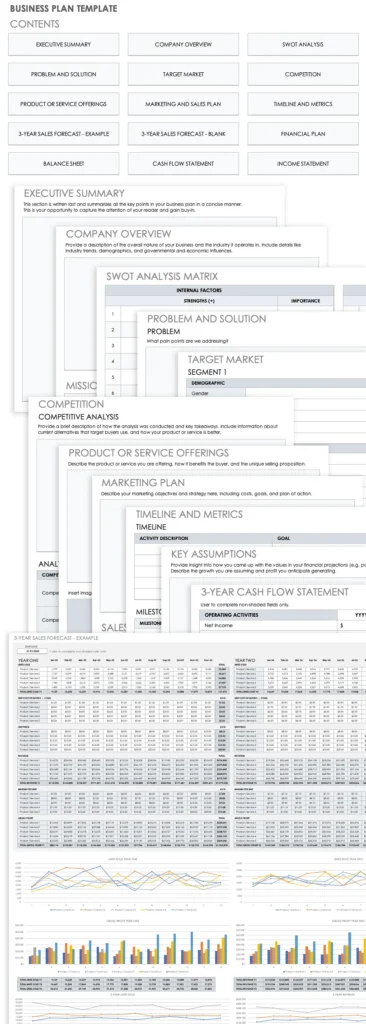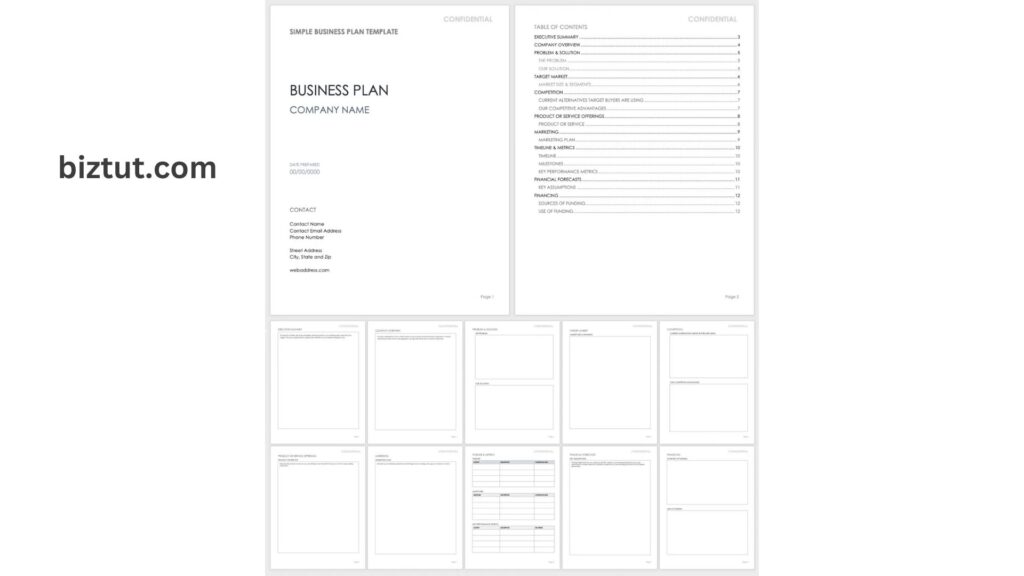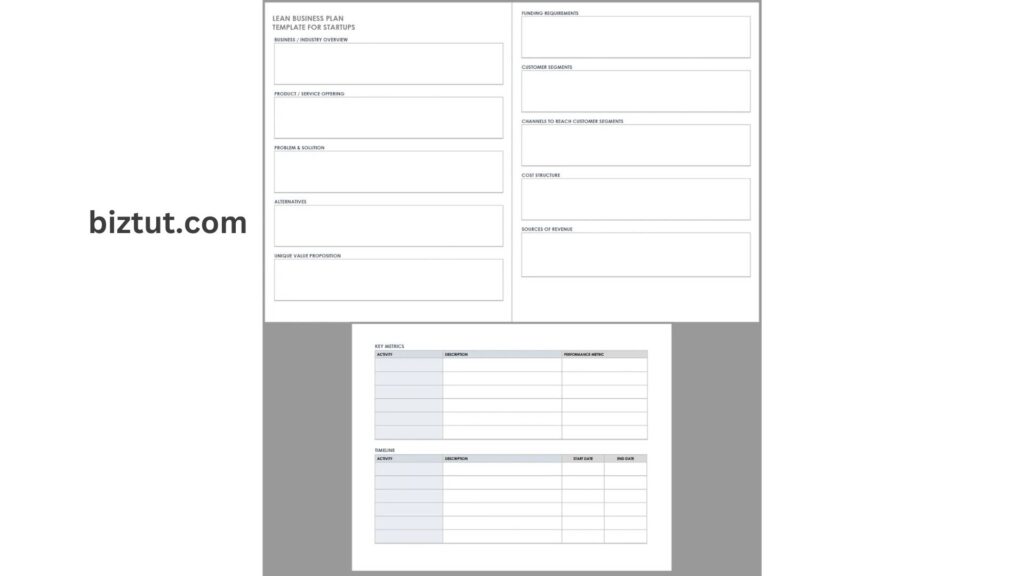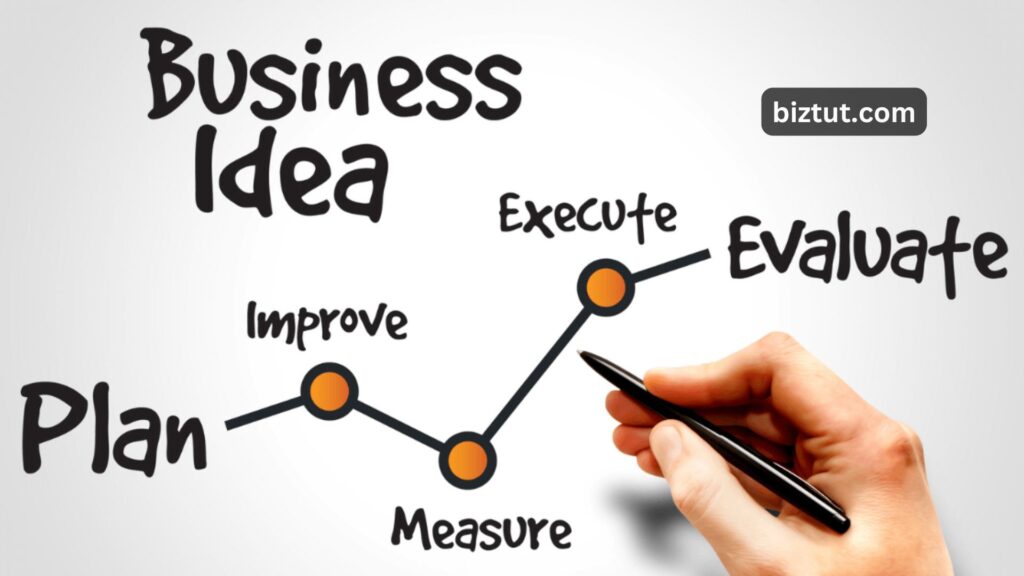A business plan is essential for any successful company, no matter its size or industry. This step-by-step guide will help you write a business plan that fits your organization, no matter where you are in your journey. You’ll find free templates and expert advice along the way.
On this page, we’ve included a simple guide to writing a business plan, along with a chart to help you figure out which type of plan you should create. Plus, you’ll discover how a solid business plan can help your business grow, along with tips from experts on how to write one effectively.
What Is a Business Plan?
A business plan is a document that lays out what a company wants to achieve, along with the steps, finances, and timelines needed to get there. It often includes a mission statement and details about the specific products or services offered.
The focus of a business plan can change depending on where your company is in its journey and what its goals are. Typically, a solid business plan will cover these key points:
- Monthly product goals and deadlines
- Monthly financial projections for the first two years
- Profit and loss statements for the next three to five years
- Balance sheet projections for the next three to five years
Startups, entrepreneurs, and small businesses create business plans to guide them as they grow. Even larger organizations may draft and update their business plans to stay on track with their big-picture goals, finances, and timelines.
While it’s important to have a clear outline of your business goals and finances, creating a business plan also helps you assess how viable your company is, when it will start making a profit, and how much money you might need from investors. Plus, having a well-defined plan keeps you accountable and can attract investors, making it a smart strategy for growth.
For more details, check out our complete guide to writing a strategic plan or download some free templates. This page is focused on for-profit business plans, but you can also find templates for nonprofit business plans in our other article.
Business Plan Steps
The details in your business plan will depend on your venture’s needs and goals, but a typical plan usually includes these key sections:

- Executive summary
- Description of the business
- Market analysis
- Competitive analysis
- Organizational management overview
- Product or service description
- Marketing plan
- Sales strategy
- Funding details (or a request for funding)
- Financial projections
If your plan is long or complex, think about adding a table of contents or an appendix for easier reference. For a deeper look into each section, check out “How to Write a Business Plan Step by Step” below.
Your audience can include anyone interested in your organization, such as potential and current investors, customers, team members, suppliers, and vendors.
Do I Need a Simple or Detailed Plan?
The level of detail in your plan depends on your business’s stage and who it’s for. Large corporations often need a detailed plan that can be up to 100 pages long. In contrast, small businesses or startups usually benefit from a shorter plan that highlights financials and strategy.
How to Choose the Right Plan for Your Business
To figure out which type of business plan you need, ask yourself, “What do we want the plan to achieve?” Start with the function, and then the format will follow.
Use the chart below to help decide what type of business plan to create:
| Function | Audience | Type of Business Plan |
|---|---|---|
| Serve as a loose guide of objectives and timeline | Internal | Lean |
| Serve as a detailed, concrete blueprint of goals | Internal | Traditional |
| Serve as a strategic document focusing on overall goals | Internal | Strategic |
| Earn a company loan or grant | External | Traditional (focus on finances) |
| Attract investors or partners | External | Traditional/strategic (focus on finances and support departments) |
| Test a business or startup idea | Internal | Lean |
Is the Order of Your Business Plan Important?
There’s no strict order for your business plan, except for the executive summary, which should always be first. After that, just organize the plan in a way that flows logically.
The Difference Between Traditional and Lean Business Plans
A traditional business plan follows a standard structure and is more detailed, often requiring more work and running dozens of pages long. A Lean business plan is less common and focuses on summarizing key points for each section, typically fitting on just one page.
Generally, you should use a traditional model for established companies or larger businesses. Choose a Lean approach if you expect the company to change quickly or if you already use a Lean strategy in other areas. A Lean business plan works well for internal purposes, but if you’re presenting to investors, stick to a traditional version since they might prefer more stability and detail.
How to Write a Business Plan Step by Step
Creating a solid business plan takes some research and careful attention to each section. Here’s a simple 10-step guide to help you research and define every part of your plan.
Step 1: Executive Summary
The executive summary is always the first part of your business plan. It should answer these key questions:
- What is the vision and mission of the company?
- What are the company’s short-term and long-term goals?
For examples and templates, check out our roundup of executive summary samples. You can also read our guide for more tips on writing an effective one.
Step 2: Description of Business
In this section, you’ll describe what your business is all about. Try to answer these questions clearly and concisely:
- What business are we in?
- What does our business do?
Step 3: Market Analysis
Here, you’ll show that you understand the current market and that your product or service fills a specific need. Answer these questions:
- Who is our customer?
- What does that customer value?
Step 4: Competitive Analysis
Often, a business plan isn’t for a completely new idea but for a more competitive version of what’s already out there. In this section, answer these questions to show how your product or service can outshine the competition:
- Who are our competitors?
- What do they do best?
- What is our unique value proposition?
Step 5: Description of Organizational Management
This section is all about the people who will help your business succeed. Write an overview of your team members and their roles, and if you can, include how your team is structured.
Step 6: Description of Products or Services
Clearly define your product or service and the resources that go into creating it. The quality of your product is crucial to your business’s success, so make sure to test and refine it before diving into marketing or sales.
Answer these questions in this section:
- What is the product or service?
- How do we produce it, and what resources do we need?
Step 7: Marketing Plan
In this section, outline your marketing strategy for your product or service. You don’t need to create a full marketing plan here, but make sure to answer some basic questions, like:
- Who is the target market (if different from your current customers)?
- What channels will you use to reach your target market?
- What resources does your marketing strategy require, and do you have access to them?
- Do you have a rough estimate of the timeline and budget?
- How will you measure success?
Step 8: Sales Plan
Here, provide an overview of your sales strategy. You don’t need to write an in-depth sales plan; just outline the main objectives and strategies. Start by answering these questions:
- What is the sales strategy?
- What tools and tactics will you use to reach your goals?
- What potential obstacles might you face, and how will you overcome them?
- What’s the timeline for making sales and turning a profit?
- What metrics will show your success?
Step 9: Funding Details (or Request for Funding)
This section is crucial, especially if you plan to share your business plan with investors. You don’t need to create a complete financial plan, but be ready to answer these questions:
- How much money do you currently have, and how much do you need?
- How will you grow your team (including onboarding, team structure, training, and development)?
- What physical needs and constraints do you have (like space and equipment)?
Step 10: Financial Projections
Investors also like to see well-thought-out financial projections for the future. Depending on your business’s stage, these could cover one to five years.
While these projections won’t be perfect and need to be somewhat flexible, you should be able to estimate:
- How and when will the company start making a profit?
- How will the company maintain profits after that?
By following these steps, you can create a strong business plan that clearly outlines your goals and strategies!
Business Plan Template

This simple business plan template includes all the essential parts: an executive summary, details about your product or service, your target audience, and your marketing and sales strategies. In the finance section, you can enter your starting numbers, and the template will automatically calculate projections for sales forecasting, financial statements, and more.
If you need templates that are more specific to your needs, check out our roundup of business plan templates. You can also download a fill-in-the-blank business plan template to make things even easier.
If you’re looking for a particular template based on file type, we have dedicated pages just for Microsoft Excel, Microsoft Word, and Adobe PDF business plan templates.
How to Write a Simple Business Plan
A simple business plan is a lighter version of a traditional business plan. Unlike a one-page plan, which is just a quick snapshot (like for a presentation to stakeholders), a simple business plan can be longer and include more details.
Here are the steps to create a basic simple business plan, which you’ll also find in the template below:
1. Write the Executive Summary
This part is just like in a traditional business plan. You need to give a brief overview of what’s included in your plan, your main offering, and both your short-term and long-term goals.
2. Add a Company Overview
Describe your company’s mission and vision.
3. Provide the Problem and Solution
Clearly explain the problem you want to solve with your product or service and how your company plans to address it. Think of this as the gap in the market you aim to fill.
4. Identify the Target Market
Who are you trying to reach with your products or services? If you can, define your ideal customer profiles briefly.
5. Write About the Competition
Show that you know the market by listing your current competitors and explaining what gives you an edge over them.
6. Describe Your Product or Service Offerings
Get straight to the point: what exactly are you selling?
7. Outline Your Marketing Tactics
Without going into too much detail, describe your marketing plans.
8. Add a Timeline and Metrics for Success
Provide a rough timeline that includes milestones and key performance indicators (KPIs) you’ll use to track your progress.
9. Include Your Financial Forecasts
Give a summary of your financial plan, showing that you’ve done your homework and created solid projections. You can also list any key assumptions behind your forecasts.
10. Identify Your Financing Needs
In this section, state how much funding you need. Based on everything in your business plan, list where you plan to get the money and how you’ll use it.
Simple Business Plan Template

Use this simple business plan template to cover all the important parts of your organization, including details about financing and ways to seek additional funding. This template is fully customizable, so it can work for any business, whether you’re just starting out or already have a large company.
Check out our article with free simple business plan templates or 30-60-90-day business plan templates for more specific options. You can also browse our collection of one-page business templates.
How to Write a Business Plan for a Lean Startup
A Lean startup business plan takes a more flexible approach compared to a traditional plan. Instead of focusing on strict deliverables and timelines, it emphasizes activities, processes, and relationships, allowing for adaptability in all areas.
While there are some similarities between traditional and Lean business plans, you can create a Lean plan by following these steps:
1. Add Your Value Proposition
Start by clearly describing your product or service. What unique value does your startup bring to customers? Make sure everyone on your team understands this core offering and can express it in simple, clear language.
2. List Your Key Partners
Identify any businesses you’ll collaborate with to achieve your vision. This includes external vendors, suppliers, and partners. This section shows that you’ve thought about the resources you can provide internally and have researched possible external help.
3. Note the Key Activities
Outline the main activities of your business, such as sourcing, production, marketing, distribution channels, and building customer relationships.
4. Include Your Key Resources
List the essential resources you need, like personnel, equipment, workspace, and intellectual property, to deliver your unique value.
5. Identify Customer Relationships and Channels
Explain how you’ll connect with and build relationships with customers. Provide an overview of the customer experience from beginning to end, including the places where you’ll interact with them, like online or in stores.
6. Detail Your Marketing Channels
Describe the marketing methods and communication platforms you’ll use to reach and nurture your customer relationships. This could include email, advertising, social media, and more.
7. Explain the Cost Structure
This part is especially important in the early stages of your business. Will you focus on maximizing value or keeping costs low? List your startup costs and outline how you plan to become profitable over time.

8. Share Your Revenue Streams
Over time, how will your company make money? Include not just the direct sales of your products or services but also other revenue sources like subscriptions, selling ad space, or fundraising.
Lean Business Plan Template for Startups

Startup leaders can use this Lean business plan template to share the most important information from a traditional plan. You’ll find sections for things like industry and product overviews, cost structure, revenue sources, key metrics, and a timeline. The best part? The template is fully customizable, so you can tweak it to fit the specific goals of your Lean startup.
How to Write a Business Plan for a Loan
A business plan for a loan, also known as a loan proposal, has a lot in common with a traditional business plan. However, it also needs some extra financial documents. These include your credit history, details about the loan you’re requesting, and a plan for how you’ll repay it.
You might also need to provide personal and business financial statements, information about any collateral you can offer, and details about equity investments.
Tips for Writing a Business Plan
To make your business plan stand out and increase your chances of getting funding and resources, consider these expert tips:
- Keep It Simple: Avner Brodsky, Co-Founder and CEO of Lezgo Limited, suggests using the acronym KISS, which stands for “Keep It Short and Simple.” He says, “Your business plan isn’t a college thesis. Just focus on the essential information.”
- Do Your Research: Michael Dean, Co-Founder of Pool Research, emphasizes the importance of thorough research. He advises business leaders to “invest time in both internal and external research (market, finance, legal, etc.). Avoid being too ambitious or making assumptions. Keep everything objective, balanced, and accurate.”
- Your plan should be solid and backed by data. Brodsky adds, “Your business needs to reflect the realities of your market. Get the latest data from reliable sources to ensure your figures are trustworthy.”
- Set Clear Goals: Make sure to include specific, time-based goals in your plan. Dean notes that “short-term goals are crucial for building momentum, especially for new businesses.”
- Know (and Address) Your Weaknesses: Recognizing your weaknesses can help you tackle them faster. Dean suggests doing a SWOT analysis to identify these weak points. Brodsky agrees, saying, “Understanding your business will help you better define your mission and choose effective strategies to reach your goals.”
- Seek Feedback: Brodsky recommends getting feedback on your drafts. “Sometimes, when you’re excited about your business, an outsider can spot what you might be missing and help you avoid mistakes.”
- Use Strong Language: Shaun Heng, VP of Operations at Coin Market Cap, advises that your writing should be both persuasive and professional. He says, “Your business plan is your sales pitch to investors. You want to strike the right tone and connect emotionally, even while being formal. Use precise and descriptive language. Instead of saying something will ‘bring in as many customers as possible,’ try saying it will ‘garner the largest possible market segment.’ This way, you’ll impress even the busiest investor.”
Lastly, Dean advises, “Stay consistent and concise. Keep your tone and style steady, and use clear, precise language. Only include what’s absolutely necessary.”

Also Read: Starting a Business with No Money: A Guide
Resources for Writing a Business Plan
Using a template is a great start for creating your business plan because it gives you a clear outline of what to include. However, a more dynamic approach, like a live document or a robust program, can offer extra features, better visibility, and real-time updates. The U.S. Small Business Administration also has helpful resources for writing a business plan.
You might also want to consider business plan software. These tools let you store data, attach important documents, and share information with your team. Some popular options are LivePlan, Enloop, BizPlanner, PlanGuru, and iPlanner.
How a Business Plan Helps to Grow Your Business
Creating a business plan, both as a process and as a document, can really help your business grow. It guides you in refining your product, identifying your target audience, and developing your sales strategy. Plus, it helps you find new opportunities, secure funding, and build valuable partnerships.
But the benefits don’t stop there! Writing a business plan forces you to research the market, which helps you clarify your unique value and figure out how to stand out from the competition. This process also keeps you focused on realistic financial and product goals. And when challenges come up later, your business plan will be a handy guide to help you navigate through them.
Streamline Your Business Planning Activities with Real-Time Work Management in Smartsheet
Give your team the power to excel with a flexible platform that meets their needs and adapts as those needs change.
With Smartsheet, it’s easy to plan, track, manage, and report on work from anywhere, making your team more effective and productive. You can keep an eye on key metrics and see work progress in real time through roll-up reports, dashboards, and automated workflows that keep everyone connected and informed.
When your team has a clear view of what needs to be done, there’s no limit to how much more they can achieve in the same amount of time!












